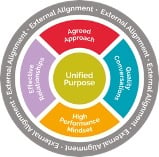Last week we ran a series of Virtual Think Tank discussions around the topics of Leading Dispersed Teams and Remote Working.
We experienced meaningful dialogue about the current realities that we have all now been thrust into. The uncertainty and volatility of the current context is an insight into a future ways of working. Research indicates that remote working is here to stay and will become more common.
So what are we learning now that will be helpful in the future?
Human First
We are distancing ourselves from in-person contact with colleagues. We are now working in our kitchens, basements and bedrooms. Small children and dogs in the background are now what we expect when we speak to each other. We can no longer operate with a ‘work’ persona alone. We also need to be a parent, partner and friend at the same time. Doing this successfully is hard. Those we are interacting with have a craving to connect and share as humans first.
- Start meetings with informal time to discuss whatever emerges. A quote from last week was “people working remotely are THIRSTY to stay connected!”
- Take time to connect with empathy for others. Be curious about their own reality, be present when others share and truly listen.
- There is inherent value in disclosure, simply the sharing of challenges you face encourages others to do the same. This kind of disclosure builds effective relationships and trust.
Intentional Connection
There is a difference between checking in with someone to checking up on someone. Less visibility of the work combined with a drive to know what is actually happening, can result in behaviors that actually reduce productivity. An important leadership need is to connect in a way that stimulates autonomy. Meetings need to have a purpose.
- Be intentional to leverage other viewpoints, breaking our individual frames of reference.
- Little and often for connections, to keep them meaningful.
- Informal connections also serve a purpose. Virtual lunch, coffee breaks, happy hour and open meetings give structure for inclusion.
Testing Assumptions
We are all feeling the shift from working in person to working in virtual and dispersed ways. The teams we are a part of, or lead, have important stakeholders. However, we cannot work under the same assumptions that our stakeholder’s needs remain the same. High performing teams are surfacing assumptions and testing those assumptions.
- It is helpful for dispersed teams to re-define who stakeholders are and if they have changed.
- Our stakeholders may well have different expectations of the team. Establish an appropriate cadence to check expectations.
- As needs shift, it is helpful to re-assess how stakeholder expectations align with the team’s own purpose.
Clarity of Why
We know that high performing teams have a sense of purpose and meaning. Having a clear and aligned sense of why this team exists becomes a solid foundation for teams to be successful, in particular when those team members cannot be in the same physical space. It’s hard to recreate the same working dynamic and functionality being remote.
- Schedule time to have a conversation about the shifting purpose of the team.
- Aligning communications to the team’s unifying purpose keeps focus for activity.
- Connect to discuss which goals are truly shared goals across the team.
Establish Boundaries
We are experiencing that a new way of working requires a new mindset in order to be effective. Our old habits and routines must change. We can still be highly productive with the re-establishment of boundaries for ourselves and others. What are we willing to let go of in order to adapt to a new normal?
- Identify productive times in the day for focused work and be mindful of colleagues who have their own schedule and flexible working times. A 9-5 working day is no longer fit for purpose and trust is essential; have faith in your team to solve the problems they are facing. Most importantly be empathetic, ask how you can help and ask for what you need.
- Clarify the 2 or 3 priorities for you and your teams to be successful.
- Be realistic with what can be done and when responses are needed, not everything requires an immediate answer.
Align on the How
What are the written or unwritten rules of engagement that your teams are following in a remote context? For many, the changes to work remotely have come suddenly and without time for proper planning. We need to be taking time to discuss how teams are collaborating in order to be successful.
- Opening up an inclusive discussion about the norms for a dispersed team and writing them down for reference.
- Encourage non-traditional collaboration structures to create autonomy such as peer to peer formats.
- Quickly up-skill everyone with the functionality of virtual tools including chat, whiteboards, collaborative document creation.
Impact’s Team Performance Model was used as an anchor for dialogue in last week’s virtual think tank. Each of the six approaches are outlined in the above map against the domains in the model, a reminder of the six interlocking factors that combine to create a high performing team.

Scott Rose is VP of consultant services at Impact. For more information on leading dispersed and remote teams, or to enquire about a follow-up session for your company, please contact us here.
